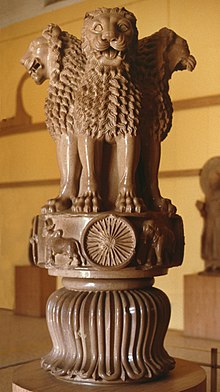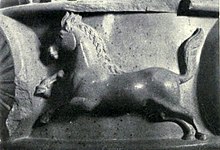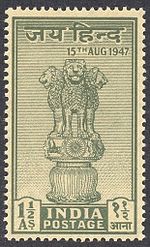Lion Capital of Ashoka

The Lion Capital of Ashoka is a sculpture of four Asiatic lions standing back to back, on an elaborate base that includes other animals. A graphic representation of it was adopted as the official Emblem of India in 1950.[1] It was originally placed on the top of the Ashoka pillar at the important Buddhist site of Sarnath by the Emperor Ashoka, in about 250 BCE.[2] The pillar, sometimes called the Aśoka Column, is still in its original location, but the Lion Capital is now in the Sarnath Museum, in the state of Uttar Pradesh, India. Standing 2.15 metres (7 feet) high including the base, it is more elaborate than the other very similar surviving capitals of the pillars of Ashoka bearing the Edicts of Ashoka that were placed throughout India several of which feature single animals at the top; one other damaged group of four lions survives, at Sanchi.[3]
The capital is carved out of a single block of polished sandstone, and was always a separate piece from the column itself. It features four Asiatic Lions standing back to back. They are mounted on an abacus with a frieze carrying sculptures in high relief of an elephant, a galloping horse, a bull, and a lion, separated by intervening spoked chariot-wheels. The whole sits upon a bell-shaped lotus. The capital was originally crowned by a 'Wheel of Dharma' (Dharmachakra popularly known in India as the "Ashoka Chakra"), with 32 spokes, of which a few fragments were found on the site.[4] A 13th-century replica of the Sarnath pillar and capital in Wat Umong near Chiang Mai, Thailand built by King Mangrai, preserves its crowning Ashoka Chakra or Dharmachakra.[5] The wheel on the capital, below the lions, is the model for the one in the flag of India.
Art history

Currently seven animal sculptures from Ashoka pillars survive.[6][7] These form "the first important group of Indian stone sculpture", though it is thought they derive from an existing tradition of wooden columns topped by animal sculptures in copper, none of which have survived. There has been much discussion of the extent of influence from Achaemenid Persia, where the column capitals supporting the roofs at Persepolis have similarities, and the "rather cold, hieratic style" of the Sarnath sculptures especially shows "obvious Achaemenid and Sargonid influence".[8]
Very similar four, lion sculptures are on the capitals of the two columns supporting the south torana of the Ashokan or Satavahana enclosure wall round the Great Stupa at Sanchi. Like other Ashoka pillars, the one at Sarnath was probably erected to commemorate a visit by the emperor.
Rediscovery


There was no surviving traces above ground of the Sarnath pillar, mentioned in the accounts of medieval Chinese pilgrims, when the Indian Civil Service engineer F. O. Oertel, with no real experience in archaeology, was allowed to excavate there in the winter of 1904–05. He first uncovered the remains of a Gupta shrine west of the main stupa, overlying an Ashokan structure. To the west of that he found the lowest section of the pillar, upright but broken off near ground level. Most of the rest of the pillar was found in three sections nearby, and then, since the Sanchi capital had been excavated in 1851, the search for an equivalent was continued, and it was found close by. It was both finer in execution and in much better condition than that at Sanchi. The pillar appeared to have been deliberately destroyed at some point. The finds were recognised as so important that the first onsite museum in India (and one of the few then in the world) was set up to house them.[9]
The Lion Capital served as the pedestal of a large stone Dharma-chakra with 32 spokes, which was found broken into pieces.[10] This Dharma-chakra was intended by three Constituent Assembly to be the symbol of India. However, mistakenly the smaller dhakrachakra with 24 spokes became the symbol. The mistake was pointed out to Jawaharlal Nehru, by Radha Kumud Mukherjee, historian, scholar and Rajya Sabha Member during Jawaharlal Nehru's administration; however, Nehru decided to stick with the 24-spoke wheel.[11] The symbol for the Supreme Court of India preserves the image of dharma-chakra on top of the Lion Capital.
Symbolism

What is being preached may be symbolised by the group of four lions of the capital. A group of four lions joined back to back symbolizes a group of four things of equal importance. The lion is frequently used as a symbol of the Buddha, as at Sanchi, and the animals on the abacus below also have symbolic meaning in Buddhism.[9] The capital is clearly Buddhist and Mauryan in origin and thus probably symbolizes the spread of Dharma, and perhaps the extent of the Maurya Empire in all directions, or four parts of the empire. Alternatively, the group of four lions and bell jointly symbolize preaching of 'the Four Noble Truths' of Buddhism to all; those that emphasize the Middle Path. The symbol U with a vertical line placed symmetrically inside it symbolizes 'The Middle Path'. The Middle Path is the fundamental philosophy of Buddhism, the Buddhist Dharma.

A further clue could be the cylindrical portion of the Lion Capital. On the wall of the cylinder the bull, the horse, the Lion and the Elephant all in the moving position are being placed in between the Chakras. These could symbolize Bull, Lion, Horse and Elephant rolling the Chakras.
A study of the ancient coins and other archaeological finds of India and Sri Lanka reveals the fact that Buddha had been symbolized with a Horse, Lion, Bull, Elephant and a pair of feet. The Tamil epic Manimekalai mentions worship of a pair of feet. Pairs of feet made of stone had been discovered in Jaffna Peninsula, Anuradhapura and in a number of places of Tamil Nadu.In a number of Buddhist inscriptions of Tamil Nadu and Sri Lanka, a pair of feet had been symbolized with a pair of fish or a pair of conch shells. In this way the symbols sculpted in the cylindrical portion of the Lion Capital represents Buddha rolling the Dhamma Chakra; that is, Preaching the Dhamma.
As Theravada Buddhism rejects symbolization of Buddha and Buddhism, the Lion Capital may be claimed as one of the finest sculptures of the main tradition that developed into Mahayana Buddhism several centuries later.[citation needed]
Government act
Whenever the emblem is used by state governments or any other government body, the words Satyameva Jayate ("Truth alone triumphs") in Devanagari script (सत्यमेव जयते) must be used right under the emblem as per the statute, State Emblem of India (Prohibition of Improper Use) Act, 2005.[14]
Similarities with the Sanchi capital

A pillar of finely polished sandstone, one of the Pillars of Ashoka, was also erected on the side of the main Torana gateway at Sanchi. The bell-shaped capital consists of four lions, which probably supported a Wheel of Law.[17] The capital is located at the nearby Sanchi Archaeological Museum. The capital is rather similar to the Sarnath capital, except that it is surmounted by an abacus and a crowning ornament of four lions, set back to back, the whole finely finished and polished to a remarkable luster from top to bottom. The abacus is adorned with four flame palmette designs separated one from the other by pairs of geese, symbolical perhaps of the flock of the Buddha's disciples. The lions from the summit, though now quite disfigured, still testify to the skills of the sculptors.[18]
Notes
- ^ State Emblem, Know India india.gov.in
- ^ "Sarnath site". Archived from the original on 7 June 2017. Retrieved 2 October 2014.
- ^ Harle, 24
- ^ Allen, caption at start of Chapter 15
- ^ "Wat Umong Chiang Mai". Thailand's World. Archived from the original on 3 December 2013. Retrieved 26 November 2013.
- ^ Himanshu Prabha Ray. The Return of the Buddha: Ancient Symbols for a New Nation. Routledge. p. 123.
- ^ Rebecca M. Brown, Deborah S. Hutton. A Companion to Asian Art and Architecture. John Wiley & Sons. p. 423-429.
- ^ Harle, 22, 24, quoted in turn; Companion, 429-430
- ^ a b Allen, Chapter 15
- ^ Vasudeva S. Agrawala (March 1964), "The Heritage of Indian Art: A Pictorial Presentation". Publications Division Ministry of Information & Broadcasting
- ^ Dola Mitra (18 January 2016). "32 Spokes Of Wisdom". Outlook India.
- ^ India Postage Stamps 1947-1988.(1989) Philately branch, Department of Posts, India.
- ^ Souvenir sheet of the Independence series of stamps, Indian Posts, 1948
- ^ "Has Telangana government got the emblem wrong?". The Economic Times. Retrieved 2 October 2014.
- ^ Drawing reconstruction by F.C. Maisey for reference
- ^ Described in Marshall p.25-28 Ashoka pillar.
- ^ Buddhist Architecture by Huu Phuoc Le p.155
- ^ Marshall, "A Guide to Sanchi" p.90ff Public Domain text
References
- Allen, Charles, Ashoka: The Search for India's Lost Emperor, 2012, Hachette UK, ISBN 1408703882, 9781408703885, google books
- "Companion": Brown, Rebecca M., Hutton, Deborah S., eds., A Companion to Asian Art and Architecture, Volume 3 of Blackwell companions to art history, 2011, John Wiley & Sons, 2011, ISBN 1444396323, 9781444396324, google books
- Harle, J.C., The Art and Architecture of the Indian Subcontinent, 2nd edn. 1994, Yale University Press Pelican History of Art, ISBN 0300062176
External links
- For Pictures of the famous original "Lion Capital of Ashoka" preserved at the Sarnath Museum which has been adopted as the "National Emblem of India" and the Ashoka Chakra (Wheel) from which has been placed in the center of the "National Flag of India" - See "lioncapital" from Columbia University Website, New York, USA
- National emblem of India
- National symbols of India
- "National Insignia", Embassy of India, Washington D.C., USA

